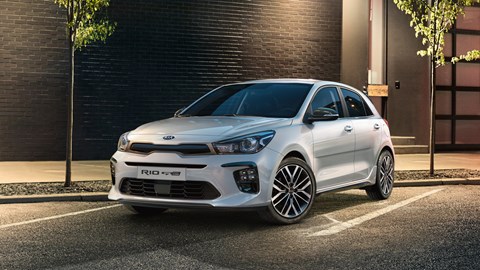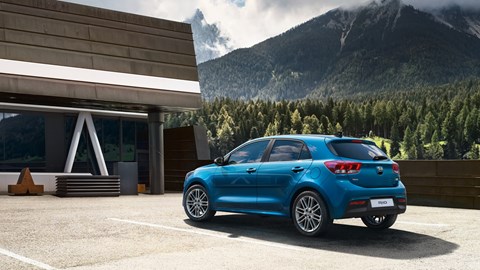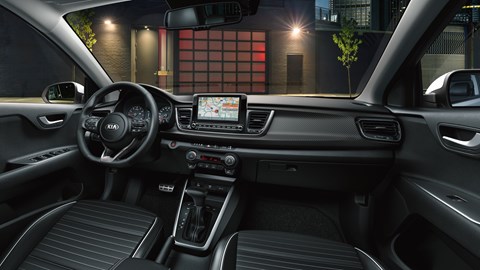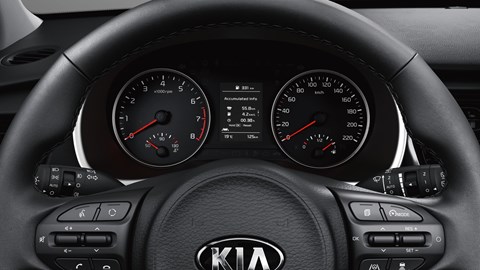► Update for Kia’s Fiesta rival
► Brand’s first mild-hybrid petrol
► On sale later in 2020
Following on from a minor update to its Sportage range a couple of weeks ago, Kia has given its Rio supermini a mid-life facelift. A fairly comprehensive package of upgrades for 2020 includes the brand’s first mild-hybrid petrol powertrain, a new ‘Intelligent Manual Transmission’ and a renewed interior with improved infotainment.
Not an exciting update, then, but a welcome refresh for a car that’s always been somewhat overlooked in the UK, especially against brilliant rivals such as the Ford Fiesta and Renault Clio.
Best superminis 2020
Looks just like the old Rio…
There isn’t much new on the styling front. You’ll find a slightly tweaked lower grille, with sharper edges and new surrounds for the foglights. GT models now get the same ‘ice-cube’ style daytime running LEDs as larger models in the range, and every car from the entry level will now include full LED headlamps, which is a nice touch.

There’s a new design of 16-inch alloy wheel and two new paint colours – Perennial Grey (yawn) and Sporty Blue (nice). In general, though, it’s very much business as usual. That’s not necessarily a bad thing – the Rio’s not a bad-looking car, with sharp lines and the now-familiar Tiger Nose grille well integrated.
So, a new mild-hybrid engine?
Yep, Kia’s first petrol version – the diesel mild-hybrid has already seen service in the Sportage. Here it takes the form of the brand’s 1.0-litre turbocharged petrol and an integrated starter-generator, paired up to a 48-volt lithium-ion battery.
As is typical for mild-hybrids, there’s no ability to drive the car on electric power alone. Rather, the motor assists in filling in torque gaps in the petrol engine’s power delivery, allows for earlier operation of the stop-start system, and recuperates energy from the crankshaft on deceleration.
What is a mild-hybrid system?
The system will be offered on two variants of this engine, producing 99bhp and 118bhp respectively. Kia reckons it’ll offer efficiency gains of between 8.1 and 10.7 per cent – though it hasn’t released WLTP economy or emissions data just yet.

The mild-hybrid offerings also get Kia’s new Intelligent Manual Transmission, or iMT. This removes the physical linkage to the clutch pedal, replacing it with a clutch-by-wire system Kia says will integrate better with the mild hybrid system to allow for greater efficiency.
In theory, it still operates as a six-speed manual gearbox. Both turbo models can also be specified with the brand’s seven-speed dual-clutch automatic.
At the entry level, Kia still offers its naturally-aspirated 1.2-litre engine with 83bhp.
What’s new inside?
The Rio’s interior design remains much the same, though Kia’s attempting to inject some personality with a new optional blue colour pack for the seat bolsters, dashboard and armrests. GT models get a swathe of carbonfibre across the dashboard and white contrast piping for the seats.
The biggest change is a new 8.0-inch infotainment touchscreen, which will be equipped with the latest Kia telematics features. Labelled UVO Connect, this offers live traffic, weather forecast, fuel prices and even parking availability depending on where you are.

There’s also a companion smartphone app which allows drivers to send route information directly to the car, check their vehicle location and access diagnostic notifications.
Naturally, Apple CarPlay and Android Auto are both offered – wirelessly – while built-in navigation is offered dependent on vehicle specification.
Any other interesting tech?
Nothing groundbreaking, but there’s plenty of safety kit that’s always nice to see in a supermini. Lane-keep assist, autonomous emergency braking with pedestrian and cyclist recognition, drive attention warning and blindspot detection are all standard equipment.

Higher-spec cars, meanwhile, get active systems including blind-spot collision avoidance, adaptive cruise control and lane-following assist.
Pricing and full specifications haven’t yet been released for the new Rio, though we’d expect it to follow Kia’s numerical spec names with a GT model as a range-topper. It’ll go on sale in the autumn, likely with a slight increase over the current model’s £13,260 starting price.